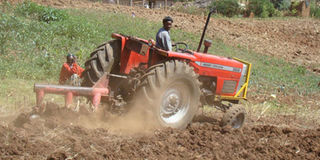City hottest in 30 years this month, says official

Land preparation: A farmer ploughs his farm in readiness for the approaching planting season. Drier seasons are normally the best time to prepare land for crop husbandry. Photo/FILE
What you need to know:
- January and February are normally the hottest and driest months of the year in the East African region which are then followed by the long rainy season when farmers plant their crops.
Nairobi is experiencing some of the hottest temperatures this February in measurements taken for a period of 30 years, the weatherman says.
Mr Peter Ambeje, the deputy director of the Kenya Meteorological Department, says the scenario has been occasioned by more prevalent cloudless skies, meaning the sun’s rays are hitting the earth’s surface directly.
“We have had days when daily maximum temperatures are higher than the projected average for the month which is 26.8 degrees Celsius with some hitting the 30 degrees mark,”
“We attribute this to cloudless days. During such moments, there is little deflection and so most of the sun’s rays reach the earth’s surface,” he says.
He added that while average temperatures may not point to an extraordinary weather condition, they were keenly following the drier and hotter days to see if they persist and accordingly inform the public.
“There is no need to panic as what we have seen is not outside our projections. In case of any development that needs Kenyans to re-adjust their lifestyles, we will inform them in advance,” he said.
January and February are normally the hottest and driest months of the year in the East African region.
Mr Ambeje said that drier seasons are normally the best time to prepare land for crop husbandry.
“It is the perfect time to prepare land because the heat kills most of the harmful micro-organisms in the soil,” he said.



